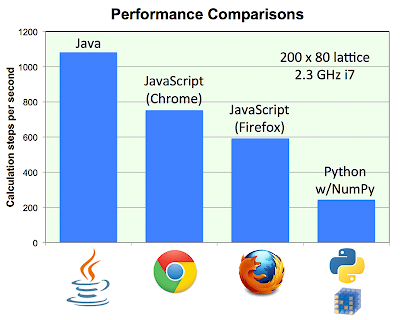Like
a number of other physics educators, I’ve invested a fair amount of time and energy over the last decade creating
educational software in the form of
Java applets.
I love Java for several reasons. It’s a reasonably easy language to learn and use, with logical rules and few exceptions. It gives very good performance, typically within a factor of 2 of native code. And, crucially, for a long time it was installed on nearly everyone’s computers, so most students and others could run my applets immediately, without any huge downloads or configuration hassles.
Unfortunately, that last advantage is now disappearing. For one thing, more and more people are replacing their computers with mobile devices that can’t run Java. Compounding the problem,
security concerns have recently prompted many people (and
companies) to disable Java on their computers. Some tech pundits have gone so far as to
pronounce client-side Java dead.
While it’s likely that Java can be kept on life-support for several more years, its long-term prospects appear grim. So it’s time for us Java applet programmers to abandon this obsolescent technology and find an alternative. But is there one?
Until very recently,
I thought the answer was no. Sure, I was aware of the new HTML5
canvas element, which allows drawing directly to the screen via JavaScript, right inside any web page, with no plugins. But this technology has mostly been described as a replacement for Flash, not Java, and I assumed that, like Flash, it would mean sacrificing a lot of performance. I couldn’t imagine that a scripting language could ever approach Java’s speed. Indeed, in an
early test of a canvas animation a few years ago, I found the performance to be so poor that computationally intensive physics simulations were unthinkable.
I then avoided thinking about the issue until this winter, when the repeated Java security alerts provided an abrupt wake-up call. Apparently knowledgable geeks all over the internet were telling the public to disable Java, insisting that nobody should ever need to use it again.
So I decided it was time to give JavaScript the HTML5 canvas another try—and I was simply stunned. At least under Chrome, I found that graphics-intensive physics simulations run about half as fast in JavaScript as they do in Java. I can absolutely live with that factor of one-half.
My specific tests were with three simulations that I’ve spent a lot of time with over the years. First I coded a basic
Ising model simulation to go with the corresponding section in my
Thermal Physics textbook. Then I tried a
molecular dynamics simulation, similar to the
computational physics project I’ve assigned many times and the
applet I wrote a few years ago. Finally, encouraged by these successes, I coded a
fluid dynamics simulation using the lattice-Boltzmann algorithm, which I learned with the prodding and help of a student, Cooper Remkes, as he worked on a class project in late 2011.
As the following graphs show, the choice of browser can make a big difference. Each graph shows the relative number of calculation steps per unit time, so higher is better in all cases. I ran the simulations on my new MacBook Pro with a 2.3 GHz i7 processor, and also on one of the Windows 7 desktop PCs in the student computer lab down the hall from my office, with a 2.93 GHz i3 chip. Comparing these two machines to each other wouldn’t be fair at all, and comparisons of the three different simulations wouldn’t be meaningful either, so I’ve normalized each group of results to the highest (fastest) value in the group. The browser versions were Chrome 25, Firefox 19, Safari 6, Opera 12, and Internet Explorer 9; all but the last of these are current, as far as I can tell. (I tried I.E. 10 on a different Windows machine and found it to be only a little faster than I.E. 9, in comparison to Chrome. I couldn’t easily find a Windows PC with Safari or Opera installed.)


The Ising model benchmark tests a mix of tasks including basic arithmetic, if-else logic, accessing a large two-dimensional array, random number generation, evaluating an exponential function, and drawing to the canvas via context.fillRect. By contrast, the molecular dynamics (MD) and fluid dynamics (FD) simulations heavily emphasize plain old arithmetic. The fluid simulation, however, does more calculation between animation frames, uses much larger arrays, and uses
direct pixel manipulation (context.putImageData) to ensure that graphics isn’t a bottleneck. The MD simulation seems to be limited, at least on the fastest platforms, by the targeted animation frame rate.
As you can see, the performance of Opera and I.E. on the MD and FD simulations is a major disappointment. Let’s hope the JavaScript engines in these browsers get some big speed boosts in the near future. Safari and Firefox seem to give acceptable performance in all cases, though neither measures up to Chrome on the demanding FD benchmark. Chrome is the clear all-around winner, although it’s a bit disappointing on the Ising simulation under Windows.
And how does this performance compare to Java? It’s hard to make a comparison that’s completely fair, because of differences in the languages and, especially, the available graphics APIs. But in general, I’ve found that similar simulations in Java run about twice as fast as the best of these JavaScript benchmarks.
The bottom line is that if you choose your browser carefully, JavaScript on a new computer is significantly faster than Java was on the computers we were using during its heyday (a decade ago). And of course, for simulations that don’t require quite as much computational horsepower, JavaScript and canvas can also reach the proliferating swarms of smartphones and tablets. I’m therefore a bit puzzled by the apparent shortage, at least so far, of physics educators who are creating JavaScript/canvas simulations. I’m sure this shortage
won’t last much longer.
[Update: See the comments below for further details on the benchmarks, especially for the Ising model simulation.]











